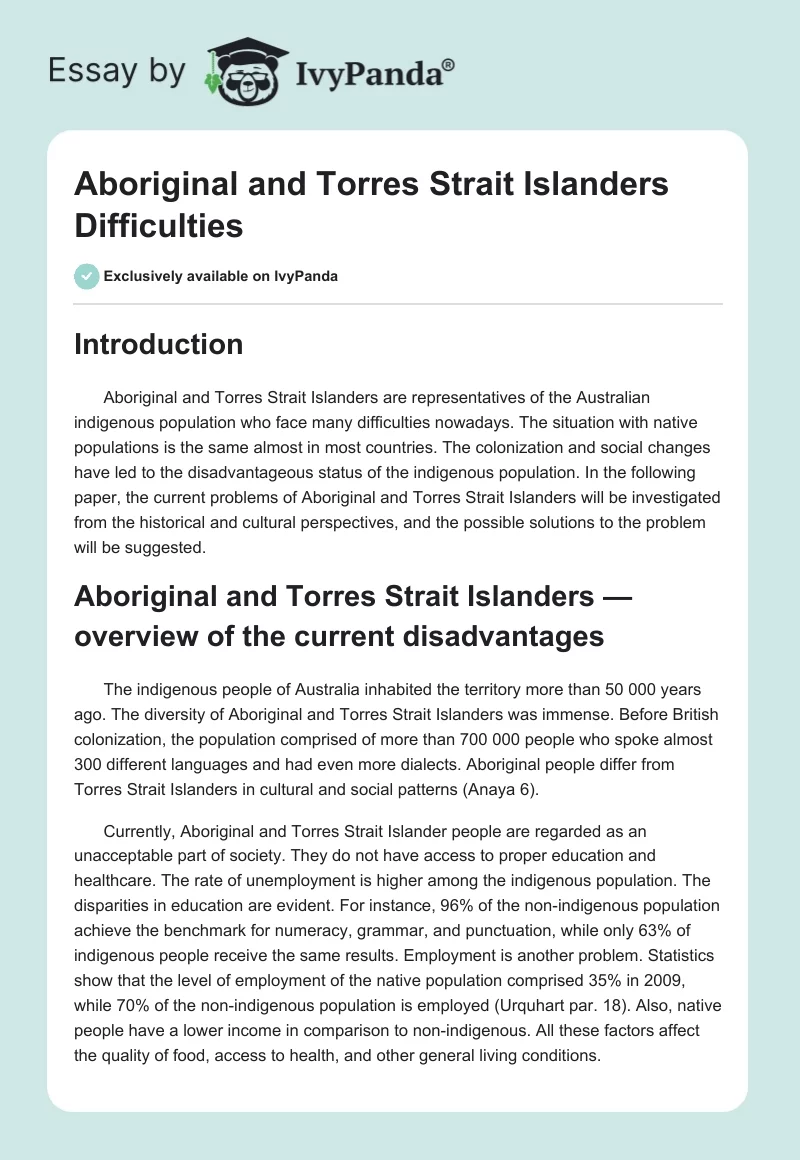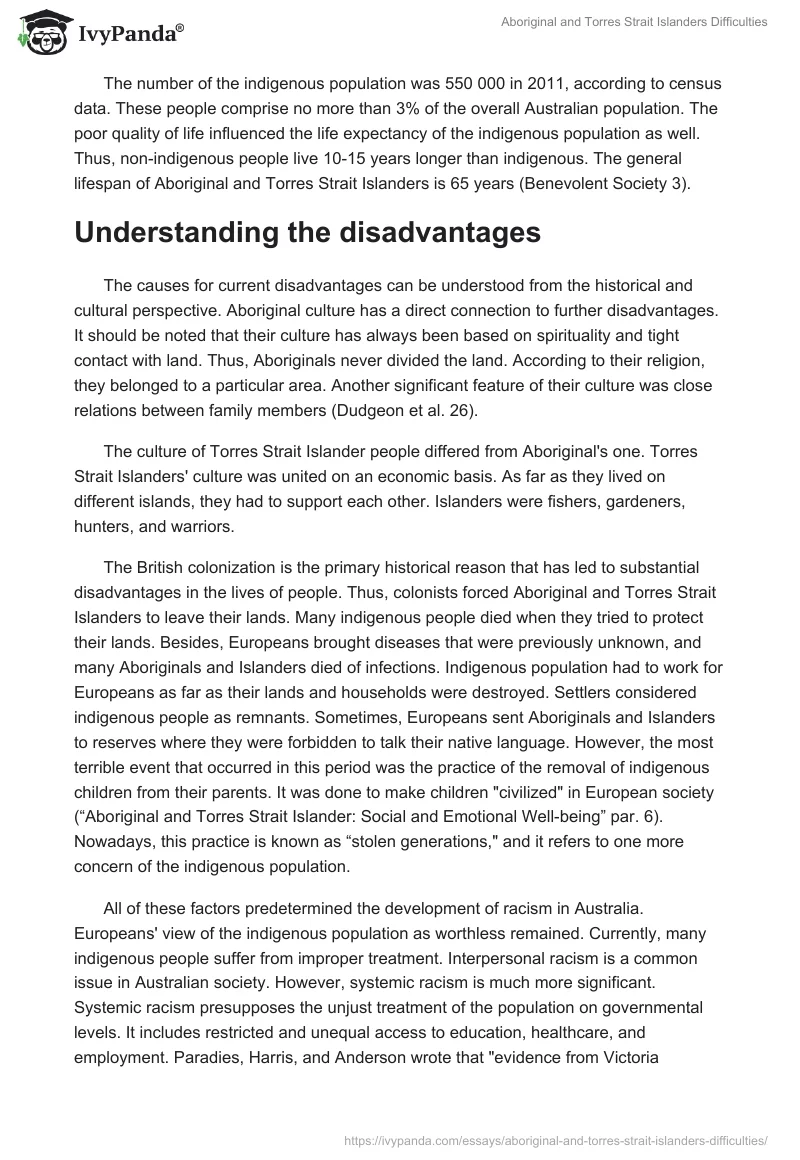Introduction
Aboriginal and Torres Strait Islanders are representatives of the Australian indigenous population who face many difficulties nowadays. The situation with native populations is the same almost in most countries. The colonization and social changes have led to the disadvantageous status of the indigenous population. In the following paper, the current problems of Aboriginal and Torres Strait Islanders will be investigated from the historical and cultural perspectives, and the possible solutions to the problem will be suggested.
Aboriginal and Torres Strait Islanders — overview of the current disadvantages
The indigenous people of Australia inhabited the territory more than 50 000 years ago. The diversity of Aboriginal and Torres Strait Islanders was immense. Before British colonization, the population comprised of more than 700 000 people who spoke almost 300 different languages and had even more dialects. Aboriginal people differ from Torres Strait Islanders in cultural and social patterns (Anaya 6).
Currently, Aboriginal and Torres Strait Islander people are regarded as an unacceptable part of society. They do not have access to proper education and healthcare. The rate of unemployment is higher among the indigenous population. The disparities in education are evident. For instance, 96% of the non-indigenous population achieve the benchmark for numeracy, grammar, and punctuation, while only 63% of indigenous people receive the same results. Employment is another problem. Statistics show that the level of employment of the native population comprised 35% in 2009, while 70% of the non-indigenous population is employed (Urquhart par. 18). Also, native people have a lower income in comparison to non-indigenous. All these factors affect the quality of food, access to health, and other general living conditions.
The number of the indigenous population was 550 000 in 2011, according to census data. These people comprise no more than 3% of the overall Australian population. The poor quality of life influenced the life expectancy of the indigenous population as well. Thus, non-indigenous people live 10-15 years longer than indigenous. The general lifespan of Aboriginal and Torres Strait Islanders is 65 years (Benevolent Society 3).
Understanding the disadvantages
The causes for current disadvantages can be understood from the historical and cultural perspective. Aboriginal culture has a direct connection to further disadvantages. It should be noted that their culture has always been based on spirituality and tight contact with land. Thus, Aboriginals never divided the land. According to their religion, they belonged to a particular area. Another significant feature of their culture was close relations between family members (Dudgeon et al. 26).
The culture of Torres Strait Islander people differed from Aboriginal’s one. Torres Strait Islanders’ culture was united on an economic basis. As far as they lived on different islands, they had to support each other. Islanders were fishers, gardeners, hunters, and warriors.
The British colonization is the primary historical reason that has led to substantial disadvantages in the lives of people. Thus, colonists forced Aboriginal and Torres Strait Islanders to leave their lands. Many indigenous people died when they tried to protect their lands. Besides, Europeans brought diseases that were previously unknown, and many Aboriginals and Islanders died of infections. Indigenous population had to work for Europeans as far as their lands and households were destroyed. Settlers considered indigenous people as remnants. Sometimes, Europeans sent Aboriginals and Islanders to reserves where they were forbidden to talk their native language. However, the most terrible event that occurred in this period was the practice of the removal of indigenous children from their parents. It was done to make children “civilized” in European society (“Aboriginal and Torres Strait Islander: Social and Emotional Well-being” par. 6). Nowadays, this practice is known as “stolen generations,” and it refers to one more concern of the indigenous population.
All of these factors predetermined the development of racism in Australia. Europeans’ view of the indigenous population as worthless remained. Currently, many indigenous people suffer from improper treatment. Interpersonal racism is a common issue in Australian society. However, systemic racism is much more significant. Systemic racism presupposes the unjust treatment of the population on governmental levels. It includes restricted and unequal access to education, healthcare, and employment. Paradies, Harris, and Anderson wrote that “evidence from Victoria indicates that when apprehended by police, indigenous youth are two to three times more likely to be arrested and charged with an offense than non-indigenous youth” (6).
Strategies to overcome disadvantages
Currently, the Australian authorities realize the urgent need to improve the quality of life of the indigenous population. One of the most significant changes within the legal framework was the introduction of the National Apology to Australia’s Indigenous Peoples in 2008. On behalf of the Parliament of Australia, Prime Minister Kevin Rudd acknowledged the adverse nature of laws that influenced the indigenous population. The Apology was addressed to the Stolen Generations as well (Osborn, Baum, and Brown 27). The human rights of the indigenous people are also protected in the Equal Opportunity Act 2010, the Racial and Religious Tolerance Act 2001, and Charter of Human Rights and Responsibilities Act 2006. There is a need for the development of the strategies that will address the most significant disadvantages that influence Aboriginal and Torres Strait Islander people. Education, employment, and racism should be addressed first.
The government should improve the quality of and access to education. The first thing to do is to provide equal education opportunities in remote areas of Australia. Besides, there is a need to alter the system of teaching for indigenous children. In my opinion, it is appropriate to establish a bilingual system of education that takes into consideration the cultural backgrounds of pupils. The existing programs for the improvement of education include the Smarter Schools National Partnership Agreements and the National Partnership Agreement on Early Childhood Education (Osborn, Baum, and Brown 20).
Employment and income are two more factors that affect the indigenous population drastically. There is no doubt that the government should provide native people with job opportunities. However, it is not an easy task. The successful strategy should start with the necessary training. Thus, Aboriginal and Torres Strait Islanders should receive assistance in vocational training and job search.
Racism is an urgent problem in Australian society as far as it is the primary reason for all other disadvantages. The approach to reducing racism should be multi-dimensional. The government should establish initiatives that will educate all other people about the false conceptions concerning indigenous people. Anti-racial social marketing campaigns can be useful for influencing non-indigenous youth. Besides, the authorities should promote national advocacy of cultural diversity and ethnicity. Finally, all these issues should be continuously monitored.
It is also worthwhile mentioning that effective communication and collaboration with indigenous people would be impossible if other residents of the country are not ready to accept them. Thus, everybody should work on his or herself to avoid prejudices and respect cultural diversity.
List of resources
The following resources can be used for addressing the problem of Aboriginal and Torres Strait Islander people:
- “What works? A review of actions addressing the social and economic determinants of Indigenous health” is a national survey of the current issues related to the native population. The authors provide a detailed record of the status of Aboriginal and Torres Strait Islanders in various settings;
- Australian Indigenous HealthInfoNet is the online source that provides all necessary information concerning the ways to close the gap between indigenous and non-indigenous population;
- “The Situation of Indigenous Peoples in Australia” is a 2010 report prepared for the General Assembly of the United Nations. The aim of the report is to discover the most urgent issues concerning human rights and suggest possible solutions to the problem;
- “The Impact of Racism on Indigenous Health in Australia and Aotearoa: Towards a Research Agenda” is research of Yin Paradies, Ricci Harris, and Ian Anderson. The survey can be useful for addressing racism-related issues as far as it presents the current evidence proving the social inequality and discrimination in Australia;
Conclusion
Aboriginal and Torres Strait Islander people face numerous disadvantages in Australia. The reasons for such treatment go far to the times of the British colonization. The compulsory confiscation of lands and humiliation of the indigenous population by settlers predetermined the current difficulties. Nowadays, the representatives of indigenous people have worse education and lower level of income than the non-indigenous population. The government should establish various strategies that would address the problem of discrimination and inequality.
Works Cited
Aboriginal and Torres Strait Islander: Social and Emotional Well-being 2005. Web.
Anaya, James. The Situation of Indigenous Peoples in Australia. 2010. Web.
Benevolent Society. Working with older Aboriginal and Torres Strait Islander people.n.d. Web.
Dudgeon, Pat, Helen Milroy and Roz Walker. Working Together. Subiaco, Western Australia: Telethon Institute for Child Health Research, 2013. Print.
Osborn, Katy, Fran Baum and Lynsey Brown. What works? A review of actions addressing the social and economic determinants of Indigenous health. 2013. Web.
Paradies, Yin, Ricci Harris and Ian Anderson. The Impact of Racism on Indigenous Health in Australia and Aotearoa: Towards a Research Agenda. 2008. Web.
Urquhart, Brian. Summary of Selected Social Indicators. 2009. Web.


